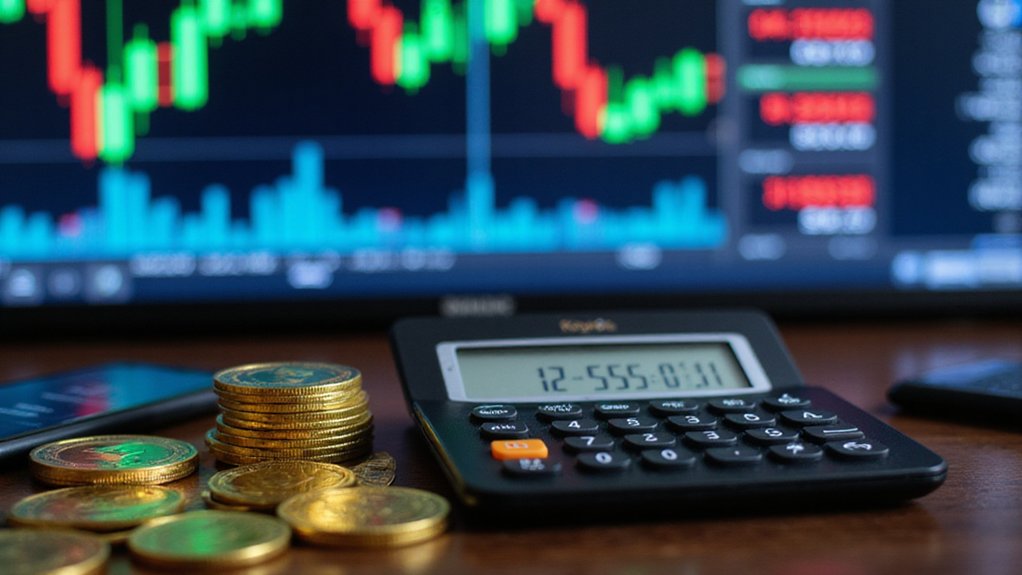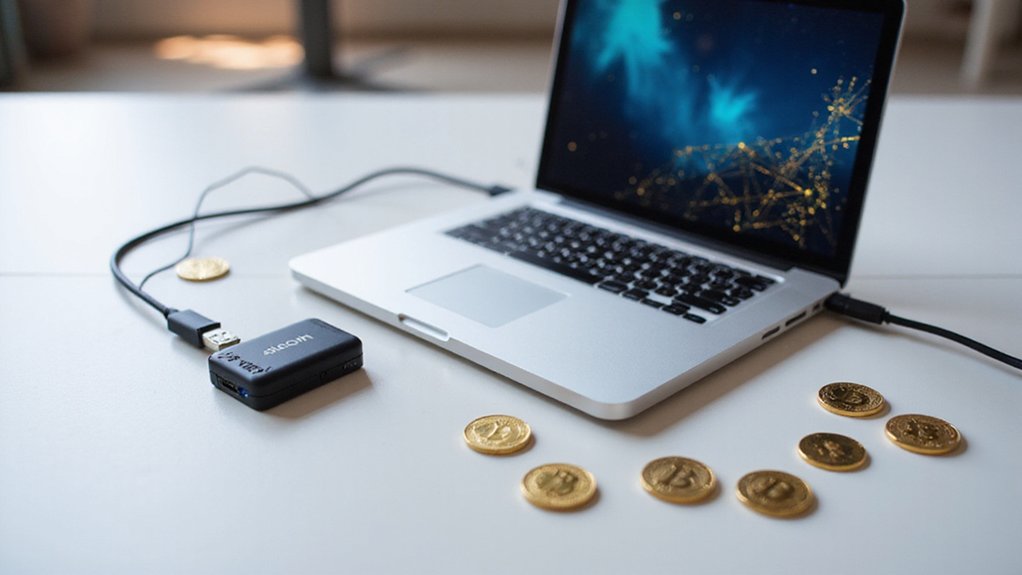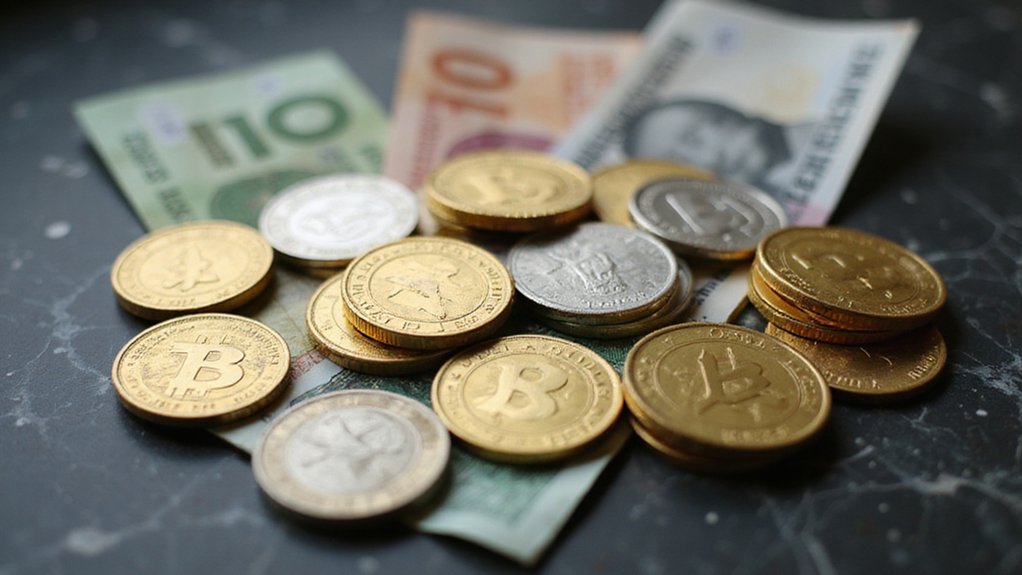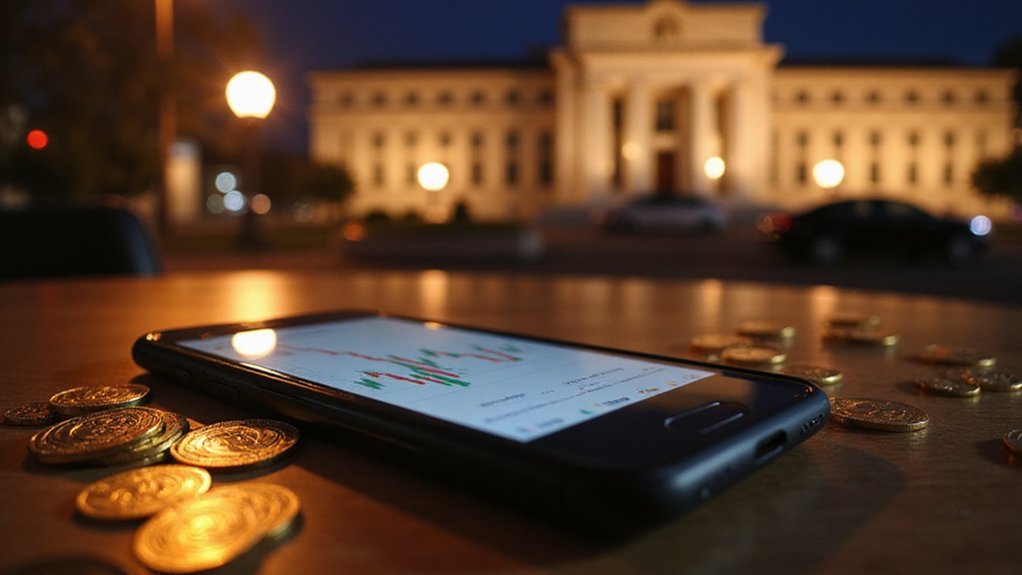Calculating crypto gas fees requires multiplying gas units consumed by the combined base fee and priority fee—a formula that turns every transaction into a computational cost assessment. Simple transfers demand roughly 21,000 gas units, while complex smart contract interactions require considerably more. The base fee fluctuates algorithmically with network demand (and gets burned, naturally), while the priority fee functions as validator gratuity during congestion periods. Understanding this seemingly straightforward arithmetic reveals the intricate economics governing blockchain operations.

Why do cryptocurrency transactions carry fees that fluctuate more wildly than a day trader’s mood swings? The answer lies in the intricate mechanics of gas fee calculations, where computational demand meets economic incentives in a digital marketplace that operates with algorithmic precision.
Gas fees operate on a deceptively simple formula: Units of Gas Used × (Base Fee + Priority Fee). This calculation reveals the two fundamental components that determine transaction costs. The gas limit represents the maximum computational units a user commits to spending, while the gas price—denominated in gwei (where one gwei equals 10^-9 ETH)—establishes the cost per unit. Simple transfers typically require approximately 21,000 gas units, though complex smart contract interactions demand considerably higher limits reflecting their computational complexity.
Gas fees blend computational complexity with economic incentives through a deceptively elegant formula that masks underlying market dynamics.
Since Ethereum’s London Hard Fork implemented EIP-1559, the fee structure transformed into a dual-component system. The base fee, algorithmically determined by network demand, gets burned rather than rewarded to validators—a deflationary mechanism that reduces ETH supply. Meanwhile, the priority fee (or tip) functions as a queue-jumping mechanism, incentivizing validators to prioritize specific transactions during network congestion.
Consider this practical example: a transaction requiring 30,000 gas units with a base fee of 75 gwei and a tip of 5 gwei would cost (75 + 5) × 30,000 = 2,400,000 gwei, or 0.0024 ETH. The mathematics remain straightforward, yet the variables fluctuate based on network demand, transaction complexity, and user-defined priority preferences.
Transaction speeds correlate directly with priority fees—fast processing (under 30 seconds) commands higher tips, while users accepting slower confirmation times (up to 30 minutes) can minimize costs. Network congestion influences base fees independently, creating scenarios where even patient users face elevated costs during peak demand periods. These validator incentives ensure blockchain security by motivating network participants to contribute computational resources and maintain network integrity. Beyond fee management, users can mitigate costs through second-layer solutions that provide alternative transaction processing methods.
Gas limit estimation requires careful consideration; insufficient limits result in failed transactions where fees are consumed despite incomplete execution. Conversely, overestimating leads to refunds of unused gas, though users temporarily lock up additional funds. Gas fees function similarly to wire transfer fees for network services, compensating the system for processing computational resources.
Modern wallets like MetaMask provide real-time estimation tools, enabling users to balance cost efficiency against transaction urgency while maneuvering this perpetually shifting economic landscape.
Frequently Asked Questions
What Happens if I Set My Gas Fee Too Low?
Setting gas fees too low creates a predictable cascade of inconvenience: transactions languish in mempool purgatory while validators prioritize higher-paying customers.
The blockchain, operating on pure economic incentives, simply ignores underpaid requests. Users face indefinite delays, automatic cancellations, and the delicious irony of paying twice—once for the failed attempt, again for the inevitable resubmission at market rates.
Time-sensitive trades become casualties of penny-pinching optimism.
Can I Cancel a Transaction After Submitting It With Gas Fees?
Transaction cancellation remains possible only while pending—a narrow window that closes permanently once miners confirm the transaction.
One can attempt replacement by broadcasting a new transaction with identical nonce but higher gas fees, fundamentally bribing miners to prioritize the cancellation over the original.
Success isn’t guaranteed, and the irony? This rescue operation costs additional gas fees, compounding the expense of whatever prompted the cancellation attempt initially.
Do Failed Transactions Still Consume Gas Fees?
Failed transactions absolutely consume gas fees—a particularly cruel twist in blockchain economics.
When transactions fail due to “out of gas” errors, insufficient funds, or smart contract execution problems, validators still collect their computational tribute. The network has already expended resources attempting to process the transaction, regardless of its ultimate failure.
Users effectively pay for the privilege of watching their transactions crash and burn, with no refunds forthcoming.
Which Wallets Allow Custom Gas Fee Settings?
Most major wallets offer custom gas fee settings, though with varying degrees of sophistication.
MetaMask provides extensive controls for max fee and priority fee adjustments, while Coinbase Wallet emphasizes user-friendly interfaces for manual customization.
Atomic Wallet offers preset options (slow/standard/fast) alongside advanced manual controls for EVM-compatible networks.
Crypto.com Wallet targets advanced users with nonce management capabilities.
These tools prove essential when standard fees seem unreasonable—or when one’s transaction urgency demands premium pricing.
Are Gas Fees Tax Deductible for Crypto Transactions?
Gas fees occupy a peculiar tax limbo—personal crypto investors cannot deduct them as expenses, though they mercifully adjust cost basis calculations.
Business users (miners, professional traders) enjoy proper deductibility, while selling crypto allows gas fees to reduce taxable proceeds.
The IRS treats gas payments as taxable disposals themselves, creating layered complexity.
Given the regulatory vacuum surrounding crypto taxation, conservative approaches and professional counsel remain prudent strategies.









